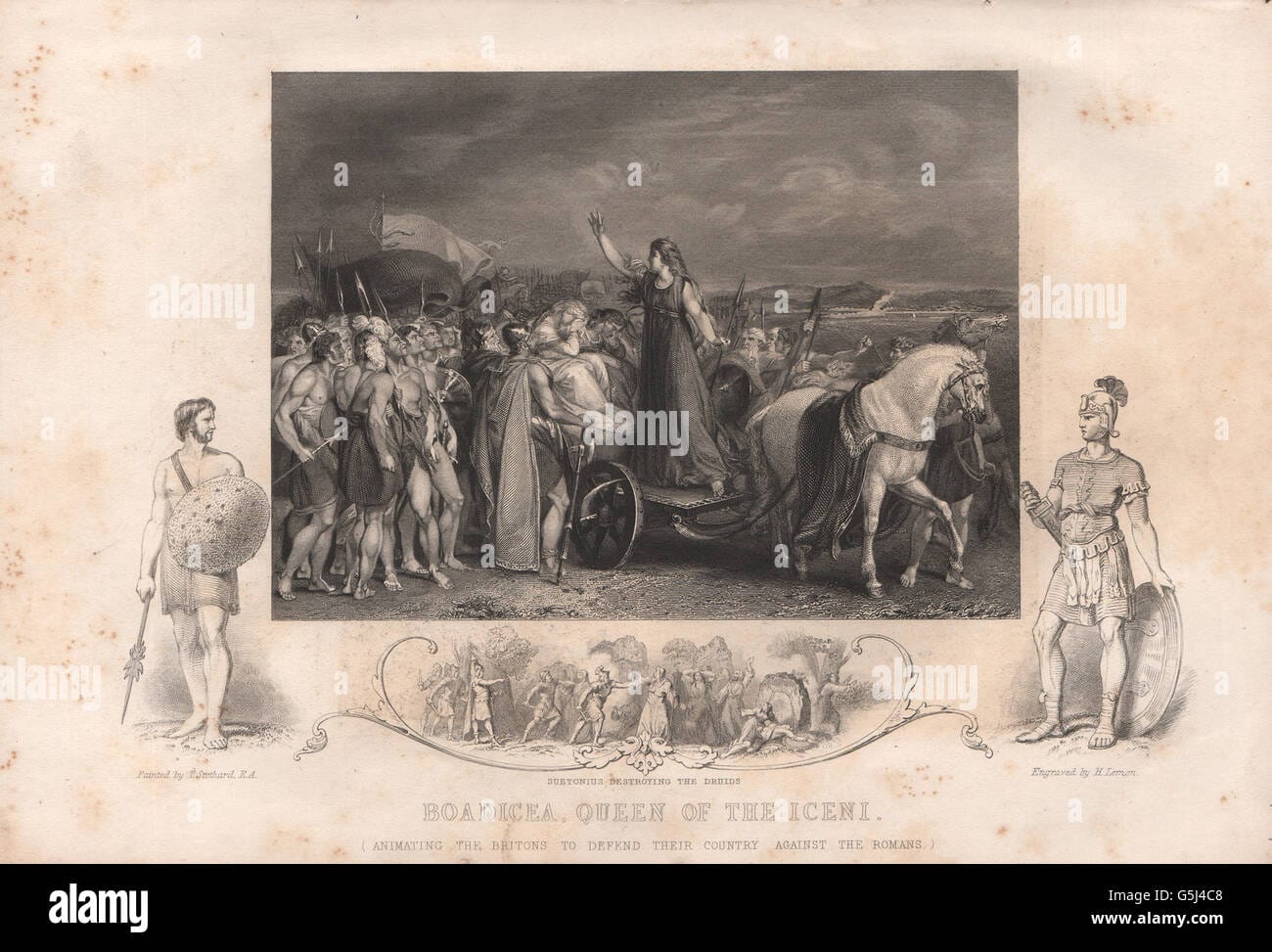The year is 60 AD. A fiery-haired queen, Boudica, rallies her people, the Iceni, against the might of the Roman Empire. Her voice, hoarse with anguish and fury, echoes across the assembled warriors, recounting the injustices inflicted upon her people and the violation of her daughters. This is not just a queen seeking vengeance; it is a nation rising up against an oppressive force. This is the story of the Iceni rebellion, a desperate struggle for freedom that shook Roman Britain to its core.
But to understand this pivotal moment in British history, we must first journey back to a time before the rebellion, to a land where an uneasy peace reigned between the Iceni people and the encroaching Roman Empire. What transformed this seemingly peaceful tribe into a force capable of challenging the might of Rome?
The Seeds of Discontent: Roman Conquest and Iceni Resistance
The Roman conquest of Britain, beginning in 43 AD, cast a long shadow over the island’s indigenous tribes. The Iceni, skilled artisans and farmers who inhabited the fertile lands of East Anglia, initially sought a path of diplomacy and strategic alliance with the Romans. Their king, Prasutagus, ruled wisely, maintaining a delicate balance between preserving Iceni autonomy and appeasing the ever-expanding Roman power.
However, beneath this façade of peaceful coexistence, resentment simmered. The Romans, despite earlier agreements, gradually increased their control over Iceni affairs, encroaching upon their lands, imposing heavy taxes, and interfering in their traditional ways of life. Prasutagus, in a bid to secure his family’s future, bequeathed his kingdom jointly to his daughters and the Roman emperor upon his death.
This act of attempted appeasement backfired disastrously. Upon Prasutagus’s death, the Romans, ignoring their treaty obligations, annexed the Iceni kingdom outright. Boudica, Prasutagus’s widow and rightful heir, was publicly flogged, and her daughters were subjected to horrific abuse. This act of barbarity became the catalyst for the Iceni rebellion, igniting the flames of revolt that had long smoldered beneath the surface.
Boudica: Warrior Queen and Symbol of Defiance
Boudica, whose name itself means “victory” in the ancient Celtic language, emerges from the annals of history as a figure shrouded in both legend and ambiguity. The primary sources for her life, written by Roman historians Tacitus and Cassius Dio, offer invaluable but inherently biased accounts, colored by their own cultural perspectives and the need to justify Roman actions.
Despite these limitations, a portrait of Boudica emerges: a woman of formidable intelligence, charisma, and political acumen. Her position as Prasutagus’s co-ruler suggests her significant influence within Iceni society, and her actions during the rebellion solidify her image as a natural leader capable of uniting disparate groups against a common enemy.
The Fires of Rebellion: A Nation’s Fury Unleashed
Driven by righteous fury and a desperate desire for freedom, the Iceni, led by Boudica, embarked on a campaign that shook Roman Britain to its core. The rebellion, erupting in 60/61 AD, was swift and merciless. Camulodunum (modern-day Colchester), a symbol of Roman authority and a settlement built upon stolen Iceni land, became their first target. The city was sacked and burned, its inhabitants slaughtered, and its buildings reduced to rubble, a testament to the Iceni’s burning rage.
The rebellion spread like wildfire, fueled by years of pent-up resentment against Roman rule. Other tribes, who had also suffered under the yoke of Roman oppression, joined the Iceni, swelling their ranks. Londinium (London) and Verulamium (St. Albans), major centers of Roman administration and trade, met the same fate as Camulodunum. The Romans, caught off guard by the ferocity and speed of the uprising, suffered heavy losses. For a brief moment, it seemed as though Roman rule in Britain might crumble entirely.
The Iceni, skilled warriors with an intimate knowledge of their land, employed guerrilla tactics and chariot warfare to great effect, initially outmaneuvering the Roman legions accustomed to more traditional battlefields. However, Rome, with its vast resources and superior military organization, would not be easily defeated.
Defeat and Legacy: The Enduring Spirit of Resistance
The Iceni rebellion, for all its initial triumphs, faced inevitable challenges. The Roman war machine, once fully mobilized, proved too formidable an opponent. At the Battle of Watling Street, the rebellion met its tragic end. The Romans, led by the experienced general Gaius Suetonius Paulinus, chose their battleground carefully, negating the Iceni’s tactical advantages. The rebels fought bravely, but their superior numbers could not overcome the disciplined Roman legions and their advanced weaponry.
The aftermath of the rebellion was brutal. The Romans, determined to crush any further resistance, unleashed a wave of reprisals, devastating the rebellious tribes and solidifying their control over Britain. While the exact fate of Boudica remains a mystery, it is believed she likely took her own life rather than be captured by the Romans, adding another layer of tragedy to her enduring legend.
Despite its ultimate defeat, the Iceni rebellion left an indelible mark on British history. It exposed the vulnerabilities of the Roman Empire, forcing a reassessment of its policies toward conquered peoples. More importantly, it cemented Boudica’s place as a powerful symbol of resistance against tyranny, an icon of courage and determination in the face of overwhelming odds.
Boudica in the Modern Age: A Legacy of Courage and Defiance
Throughout the centuries, Boudica’s legend has resonated, evolving from a figure of vengeance in Roman accounts to a national heroine during the Victorian era, often appropriated to serve political agendas. Her image, cast in bronze and stone, stands as a stark reminder of Britain’s rebellious past.
Yet, Boudica’s legacy transcends national identity. She has become a global icon of resistance, a testament to the indomitable human spirit that refuses to be broken, even in the face of insurmountable challenges. Her name continues to resonate with feminist movements, a symbol of female strength and defiance against oppression.
In literature, art, and popular culture, Boudica’s story continues to captivate and inspire. She reminds us that history is written not only by the victors but also by those who dare to resist. Her fight, though centuries past, speaks to the ongoing human struggle against oppression, reminding us that even the mightiest empires can be challenged when people unite to fight for their freedom.
The Iceni rebellion, a pivotal moment in British history, continues to fascinate and inspire. As archaeological discoveries continue to shed light on the Iceni people and their world, medieval travelers venturing to distant lands encountered diverse cultures and empires, echoing the interconnectedness of human history. The echoes of their stories, like Boudica’s, remind us of the enduring power of courage, resilience, and the timeless human struggle for freedom.
- Senior at What Age: Benefits & Eligibility Guide - March 29, 2025
- Unlocking Senior Benefits: How Old is a Senior? Your Complete Guide - March 29, 2025
- Master Russian Politeness:A Guide to Saying Please - March 29, 2025
















